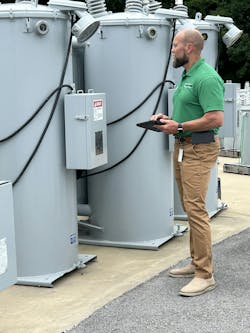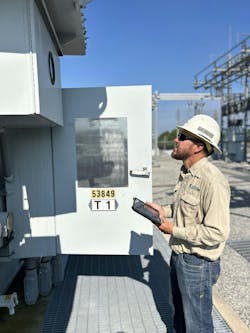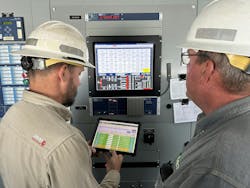UCEMC's Digital Shift: Enhancing Efficiency and Future Readiness
Key Highlights
- UCEMC experienced significant growth, increasing its meter count from 49,800 to 55,000, which heightened the need for efficient asset management.
- The cooperative transitioned from manual records to a digital platform, improving data accuracy and accessibility across departments.
- Implementation of eSmart software enabled real-time data sharing, automated work orders, and enhanced inspection processes using mobile devices.
- Automation and analytics reduced errors, saved time, and lowered operational costs, supporting proactive maintenance and decision-making.
- A phased approach, starting with substation inspections, allowed UCEMC to build momentum and expand digital processes gradually, ensuring staff buy-in and operational continuity.
Working smarter, not harder — it’s a familiar refrain, but one that still resonates, especially among electric cooperatives where rapid growth can strain efficiency and stretch limited resources. At the same time, managing aging infrastructure while preparing for future demand has become an essential priority.
Upper Cumberland Electric Membership Corporation (UCEMC) is an electric power distribution cooperative serving more than 54,000 members across eleven counties in western Tennessee.
Like many electric cooperatives, UCEMC is experiencing both commercial and residential growth in its service area. In 2017, it served roughly 49,800 meters; today, the meter count is 55,000 and growing. Much of that expansion has occurred just during the last couple of years. As a result, staying ahead of maintenance and inspections has become a growing challenge.
With the Upper Cumberland’s strategic location, strong workforce, and high quality of life, the region has become an increasingly attractive destination for businesses looking to expand or relocate — a trend reflected in the nearly 9,700 new jobs created last year in Tennessee’s rural and suburban counties.
As commercial and residential growth accelerated across its service territory, UCEMC quickly recognized that greater efficiency and enhanced data visibility would be essential to managing this momentum and meeting future demand — and it wasted no time taking action.
The Challenge: Managing Growth with Limited Resources
Like many rural cooperatives, UCEMC operates with a lean team tasked with a wide range of responsibilities. With only three substation technicians supporting a network of 13 substations and more than 4,775 miles of distribution lines, the organization feels the strain of growth.
Historically, inspection and maintenance records were handled manually, with everything recorded on paper and placed in files. In 2015, the co-op migrated to a digital environment, shifting substation inspections and equipment maintenance records from paper to Excel spreadsheets. While this shift provided an incremental improvement in documentation — certainty better than paper and filing cabinets — the process was still cumbersome, particularly when data needed to be analyzed, tracked, or shared across departments.
Tasked with managing a growing inventory of equipment, taking on additional job responsibilities, and coordinating more complex maintenance schedules, the operations team found it increasingly difficult to keep everything organized and up to date. As a result, operations and personnel felt the strain of an outdated and overburdened system.
Pulling historical trends, ensuring timely maintenance, and coordinating asset tracking were vital but time-consuming tasks. As workloads increased, the risk of error, duplication, and inefficiency also grew.
The cooperative needed more than a digital filing cabinet. It needed a tool that could bring structure, automation, and transparency to its asset management processes — without requiring a major overhaul of its limited human resources.
A Flexible Platform
UCEMC first learned about an asset management solution through a neighboring cooperative that had successfully implemented the software. After seeing demonstrations at industry conferences and speaking with peers and providers, UCEMC leaders concluded that the tool, eSmart from MinMax Technologies, could help address both their immediate needs and longer-term goals
From the start, data security was a top priority, but UCEMC’s concerns were resolved by the platform’s use of Microsoft Azure for secure cloud hosting and its ability to back up data locally in formats like PDF and Excel. That combination offered UCEMC peace of mind regarding data ownership and access, and gave stakeholders the confidence to move forward.
While dedicating time to learning new software can create organizational angst, particularly while juggling the demands of an already full workday, the implementation and training process was relatively smooth.
Implementation began with a collaborative process designed to fit the program into UCEMC’s established workflows. Rather than forcing a one-size-fits-all model, the MinMax team helped UCEMC customize inspection forms within the platform to reflect their existing documentation — adjusting the number, order, and content of questions where appropriate — while using some of eSMART’s library of information where helpful.
Training took a blended approach. Initial demos using UCEMC’s historical data made the training more relevant and applicable. Then, ongoing online sessions and an in-person training day were held to ensure a smooth rollout.
UCEMC’s substation and metering department first began using the solution to manage inspections and track substation equipment. However, it has since expanded its use to support line crews who wanted a better way of tracking their regulator field inspections.
By integrating inspection schedules tailored to the line crews’ existing forms, the system gave the Operations Manager real-time visibility into work performed in the field. The cooperative is now working to onboard additional asset categories — including reclosers, fiber, capacitor bank controls, and more — to fully automate preventive maintenance and inspection schedules across all equipment in their service territory.
A particularly forward-looking move was importing 10 years of historical inspection data from Excel into the platform. This enabled UCEMC to immediately begin leveraging the system’s analytics and trend-reporting capabilities rather than waiting to accumulate the data from software implementation.
Team members have responded positively to the ease of use and said they appreciate the “set it and forget it” nature of digital inspections. In practice, this means that once inspections are completed, data is instantly saved and visible to all relevant stakeholders.
Features like centralized asset tracking, customizable forms, and powerful reporting tools are proven standouts, helping UCEMC modernize its operations while maintaining continuity with past practices.
Streamlined and Scaled for the Future
Upper Cumberland EMC has seen measurable benefits since implementing the new asset management software in late 2024. What began as a strategy to improve substation inspections has evolved into a broader digital transformation initiative that now supports both substation and distribution system operations.
Perhaps most importantly, employee buy-in happened quickly, as the software’s versatility meets the needs of staff and provides operational efficiency. Using iPads in the field — a more mobile and user-friendly tool than laptops — field crews are more productive. Because the software is configured to the cooperative’s specifications with drop-down options, numeric values, and questions designed to match how UCEMC crews work, the inspection process has become faster and more accessible.
Substation technicians log data directly into eSMART, and once an inspection is completed, the data is instantly uploaded and available to supervisors, creating seamless visibility with relevant stakeholders, eliminating delays in data sharing, and ensuring follow-up actions can be taken without additional legwork.
By implementing the new software, UCEMC has dramatically improved its ability to maintain and manage assets proactively. In addition to enhanced productivity and efficiency, UCEMC has also experienced:
Reduced Errors: By setting allowable limits for specific questions, the user is instantly notified of any values that fall outside normal operating limits. This helps prevent the chance of human error during field inspections. Additionally, this automation not only alerts staff overseeing maintenance and inspection data so that issues requiring attention are not overlooked, but it also automatically creates work orders for timely resolution and tracking.
Reduced Costs: By incorporating the eSMART technology into substation management workflows, UCEMC has substantially enhanced its substation inspection process, significantly decreasing completion times. As Benjamin Franklin’s pithy saying goes, “Time is money.” And for UCEMC, time saved is money saved. Time is a precious commodity in the cooperative world, and by streamlining substation inspections, the savings have been noticeable.
The software has also allowed UCEMC to automate its maintenance schedules and group similar equipment together for consistency in tracking and reporting — boosting both organizational clarity and operational efficiency.
Because inspection data is immediately accessible through the reporting and analytics tools, key performance indicators (KPIs), such as system loads and maintenance progress, are easier to track and act upon.
UCEMC has now achieved several measurable milestones:
- Deployed eSMART for asset management across all substations, enabling structured and reliable monthly inspections.
- Digitized 10 years of historical inspection data — a total of 1,444 reports — enhancing insight and visibility into substation performance dating back to 2014.
- Expanded the use of the tool into distribution operations, applying it to downline devices such as voltage regulators and capacitor banks.
- Observed clear operational benefits, including productivity gains, improved data accuracy, higher inspector satisfaction, and notable cost savings.
The new program and process have laid the foundation for more strategic, data-informed decision-making. By reducing manual effort, minimizing errors, and automating key tasks, the platform has proven to be a powerful ally in future-proofing the cooperative’s approach to asset management.
Tips for Success: Start Small and Build Momentum
When UCEMC set out to automate its substation inspection workflow, leaders had four expectations to mark success:
- Make internal processes for substation management easier.
- Streamline maintenance scheduling.
- Create efficiencies in data collection and analysis.
- Track assets with ease.
In each instance, expectations were met. The asset management software that UCEMC chose has lent structure to its processes and significantly simplified how the cooperative manages its assets. However, the real bonus to UCEMC has been the software’s analytics and reporting capabilities because of the versatility and automation it offers.
The most valuable insight UCEMC offers other cooperatives considering a digital asset management platform is to start small and build momentum. For UCEMC, attempting to digitize every process simultaneously would have overwhelmed its already busy staff. Instead, the operations team prioritized one function — substation inspections — and focused on refining it within the platform before expanding to regulators and other assets.
This phased approach allowed UCEMC to improve without losing focus, gradually integrating features and workflows in a way that matched their capacity.
Ultimately, UCEMC found that digital asset management does not have to be a massive organizational shift. With the right platform, strong vendor support, and a methodical rollout plan, even small utilities can transform how they manage infrastructure.
A Future-Forward Foundation
UCEMC now has the foundation for a more innovative and sustainable operations strategy. By digitizing historical data and standardizing asset management processes, the cooperative is better equipped to meet today’s demands while laying the groundwork for tomorrow’s growth.
In an industry where time is limited and precision matters, UCEMC’s experience proves that the right digital solution can help even the smallest teams operate with greater agility, confidence, and control.
Joe Skelton ([email protected]) brings over 33 years of experience to Upper Cumberland EMC, beginning his career as a lineman before advancing into leadership roles in Operations. He has served as a Substation Technician, Supervisor of Technical Operations, and Director of Operations, overseeing key areas such as substations, SCADA systems, fiber installation, and AMI deployment.
About the Author
Joe Skelton
Joe Skelton ([email protected]) brings over 33 years of experience to Upper Cumberland EMC, beginning his career as a lineman before advancing into leadership roles in Operations. He has served as a Substation Technician, Supervisor of Technical Operations, and Director of Operations, overseeing key areas such as substations, SCADA systems, fiber installation, and AMI deployment.



